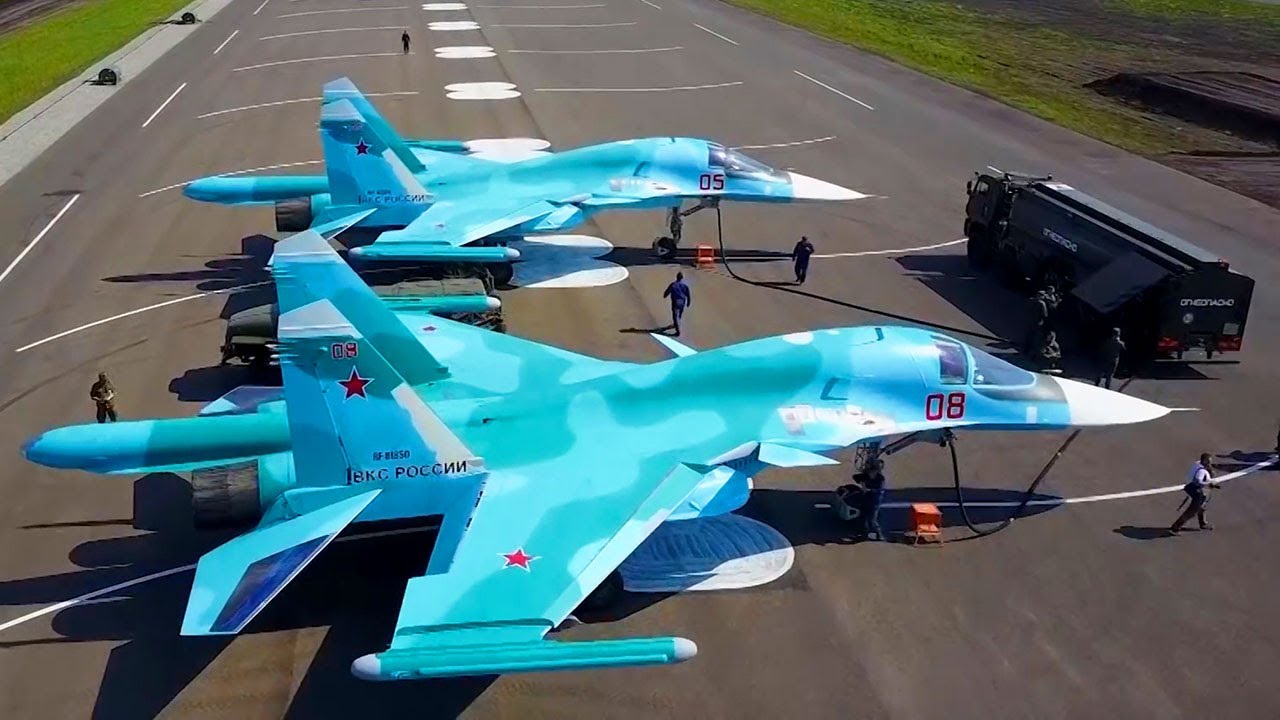A new report has surfaced that recounts how the Ukrainians attempted to convince a Russian pilot bombing Ukraine to defect with his Su-34 fighter bomber in exchange for $1 million.
The Su-34 Fullback is a twin-seater, supersonic fighter bomber, and the aircraft can operate in all weather conditions. It is designed and manufactured by Sukhoi, derived from the company’s Flanker series of fighter jets.
The Sukhoi Su-34 fighter aircraft has been instrumental in attacking Ukrainian positions, with an average of 140 sorties daily, and has been labeled as one of the most powerful fighters used by Russia in the Ukraine war.
In the early stages of the war, this ‘frontal bomber’ was used to conduct fighter sweeps and strike missions up to 300 kilometers inside Ukrainian territory at altitudes ranging from 12,000 to 30,000 feet, RUSI scholars noted.
It is worth noting that the Su-34 ‘frontal bomber’ fleet carried out most of its sorties over Ukraine using unguided bombs and rockets due to the limited availability of precision-guided munitions (PGMs).
The Russian Aerospace Forces have been conducting low-level flights, flying at or below 500 feet, using Su-34, Su-25, and Su-30SM fighter planes. This tactic evaded Ukraine’s medium-range SAMs, specifically the Soviet-made 9K33 Osa and 9K37 Buk systems.
More than 10% of the Sukhoi Su-34 Fullback fighter-bomber fleet of the Russian Aerospace Forces (RuASF) is said to have been lost during combat operations over Ukraine.
Most of these fighter-bomber jets were reportedly lost to MANPAD (Man-Portable Air Defense System) fire. In response to the threat posed by MANPADS, the VKS (Russian Aerospace Forces) began conducting penetrating sorties at night starting on March 9, 2022.
At the time, as most Ukrainian MANPADS operators did not possess night-vision goggles, the initial losses for the VKS were significantly reduced by operating under cover of darkness.
However, only one of the VKS fast jet fleets was equipped with cockpit technology and had appropriate training for contested low-level night operations, and that was the Su-34 fleet.
As a result, the Su-34 fleet was responsible for most of the remaining penetrating strike operations carried out by the VKS before such missions were reduced in April 2022.

Ukraine Spies Lured Russian Pilots
Yahoo News interviewed a Ukrainian volunteer, “Bohdan,” who came up with and launched this intricate plan to seize control of Russian Su-34 fighter aircraft.
During the previous summer, a team of Ukrainian volunteers, collaborating closely with their nation’s intelligence agency, allegedly came close to convincing a Russian Su-34 pilot to abandon his aircraft in exchange for a payment of $1 million. The pilot reportedly participated in bombing sorties over Ukraine.
Thus the Ukrainian volunteer made contact with Roman Nosenko, a Russian pilot who flies Su-34 Fullback and Su-24 Fencer bombers. Bohdan mentioned that one of their most rigorous discussions was with Nosenko, who was the most challenging to converse with.
On April 30, Nosenko wrote, “I will move my family, but what will happen there if this is not a joke? The money is huge. It looks like a scam. What are the guarantees that I will not be scammed? F***, this is like a movie.”
Bohdan received confirmation from Nosenko that he operated the Su-34 Fullback and Su-24 Fencer bombers, which require a crew of two. To verify his claim, Bohdan offered Nosenko $2,000 in exchange for evidence.
Nosenko provided photographs of his Fencer and, as requested, held up a piece of paper with the number “339” written on it in front of the plane. The Russian pilot also disclosed important information regarding the bombing sorties they conducted over Ukraine.
Nosenko stated that he had limited knowledge about the targets, saying that pilots only transport the payload to a certain point, after which it functions autonomously. He added that they are not provided with any details about the targets.
Based on Nosenko’s claims that the payload operates on its own, it is possible that they were using standoff munitions such as Kh-59 cruise missiles or Kh-31P anti-radiation missiles.
He further claimed that the pilots are not briefed beforehand on their operational plans or flight direction. The information is only revealed at the last moment, just before the flight.
The report added that Nosenko planned to drug his navigator, the only other person in the cockpit with him. Nosenko agreed to exit Russian-controlled airspace and fly over his troops at a high altitude before descending over the frontline. His primary concern was the Ukrainian air defenses.
He expressed his fear by saying, “I’ve heard they are handsomely paid to shoot-down planes.” “I would be more confident if I knew at least the areas of their deployment to go around them and start maneuvering on time confidently,” he added.
The Russian pilot also intended to take his wife out of the country, possibly through Armenia or Belarus. He planned to obtain a new passport there for her with the help of Ukrainian spies and then proceed to one of the Baltic states.
However, the entire plan was discovered by Russia’s Federal Security Service (FSB). As a result, Ukraine could only obtain critical technical information about the warplane but was unsuccessful in getting the actual aircraft.
Despite the risks, the pilot planned to fly his expensive aircraft into Ukrainian airspace, where Ukrainian interceptors would meet him and provide a safe escort to a designated landing strip, the Yahoo report claimed.
- Contact the author at ashishmichel(at)gmail.com
- Follow EurAsian Times on Google News